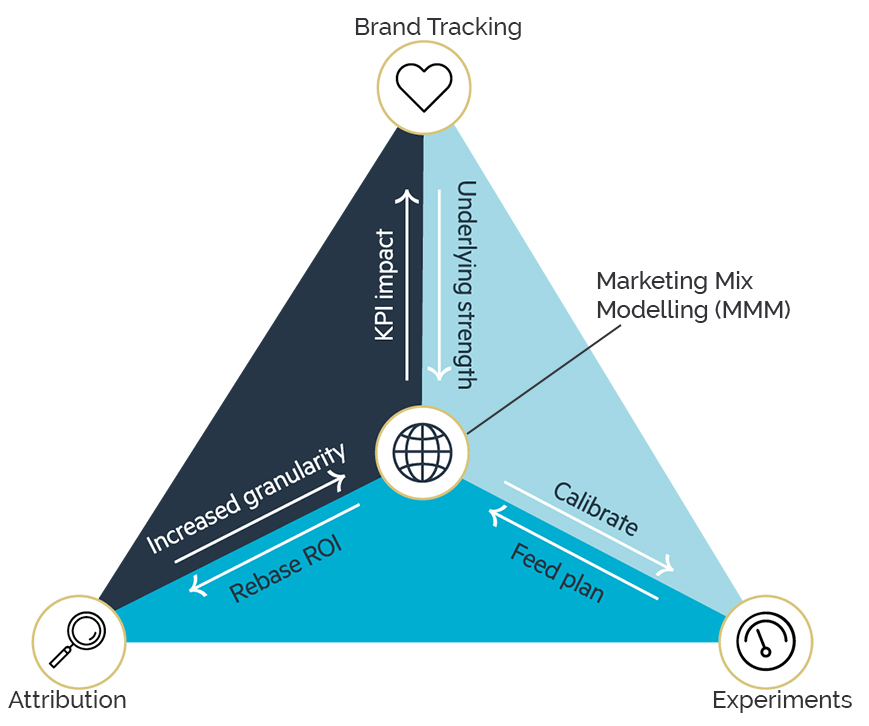Businesses that connect the different ways they measure marketing so each informs the other are better equipped to make effective decisions. It’s far from easy to do.
Google recently U-turned on its plan to phase out the use of third-party cookies on the Chrome browser. However, the company’s original 2020 announcement about the future of cookies sparked a reassessment of our industry’s over-reliance on digital attribution that continues today. It has brought a welcome resurgence in the use of Marketing Mix Modelling (MMM)/econometrics to provide marketers with a more holistic overview of the impact of their marketing activities.
Of course, most organisations continue to use some form of digital attribution to ascribe consumer actions back to exposure to specific marketing messages and formats. When deployed well, attribution can play an important role alongside MMM and other methods. This is provided that there is a good understanding of what different measurement methods contribute:
- Brand tracking allows you to understand brand awareness and perception
- Attribution helps you to make granular, tactical, and reactive decisions
- Experiments support continuous innovation and improvement
- Marketing Mix Modelling can be a comprehensive approach to budget planning, performance forecasting, and strategic decision-making.
Where measurement gets tricky is in following the thread between different solutions to steer tactical and strategic decisions from a common vantage point. Especially if solutions are siloed, often delivered by different providers, and managed by disparate teams.
Don’t just go round and round – triangulate
Enter Triangulation, or Unified Measurement. Triangulation aims to bring those threads together to allow marketers to make decisions using a common language of marketing effectiveness. This commonality ensures that decisions come from the same place, albeit with a different lens for the job in hand.
Key measurement methods & triangulation/unification
Illustration of the major measurement solutions used together to evaluate marketing performance, with MMM at the core for integration (methods can be used independently or together).

Attribution: Assigning value to digital marketing activities, such as via solutions from Meta or Google. For granular, tactical and reactive decisions (e.g. campaign optimization).
Brand Tracking: Surveys, panels, focus groups, social listening, sentiment analysis, etc. For monitoring brand awareness and perception.
Marketing Mix Modelling (MMM): Captures the full range of business drivers (inc. external factors) as an integration core. For budget planning, performance forecasting and strategic decisions.
Experiments: (Test & Control) Causal impacts through experiments, e.g. A/B testing. For continuous innovation and improvement (e.g. creative or targeting testing).
MMM – or an econometric approach – acts as the glue, the method through which to integrate all other methods, because it delivers a comprehensive view of true incrementality and its drivers.
By contrast, the picture provided by digital attribution does not show us what is happening offline or the impact of brand building activity on digital performance. Because it cannot offer a holistic view of the impact of marketing activities, digital attribution data should never have been used to influence big strategic decisions, such as budget setting.
However, by using MMM to integrate brand tracking, experiments and attribution, and each method to calibrate MMM and vice versa, you arrive at a more complete measurement solution, each informing the other to ensure the best decision-making. But it’s rarely easy to achieve.
Getting leadership support is critical
Even for data scientists, or marketing effectiveness professionals, this can be a complex field with many challenges along the way. The path to triangulation is often messy and includes missteps, and time is needed to hone the approach.
For marketing or finance professionals, it can seem impenetrable. Yet the holistic insight delivered through triangulation is critical to their decision-making; to ensuring brand health, budgets, and campaigns are optimised and that there is space for experimentation and investigating hunches, but with the backing of science to know which ones worked. It’s critical to competitive advantage.
Often, however, the biggest challenges are not methodological, but organisational. Especially in large organisations with multiple brands, products and operating territories, where teams act autonomously and differently from each other. Because true unified measurement requires teams to be open to drivers that impact performance beyond what is happening within their own remit. Leadership or C-Suite buy-in combined with change management are essential if organisations are serious about triangulation. There will be political challenges that are as important to solve as data accessibility. Sometimes more so.
Start the conversations across your teams
To aid understanding and facilitate conversations between teams about achieving triangulation, the Ekimetrics online guide to measurement outlines each method, its purpose, pros and cons, with a path to maturity, explanations of the data needed, and a glossary of important terms.
Because, increasingly, not being serious about triangulation means not being serious about competitive advantage. That’s why companies such as Sky and Specsavers have invested significant time and effort both in gaining the necessary senior leadership buy-in and driving forward a transformation programme of activity towards triangulation.
By Matt Andrew, Managing Partner, Ekimetrics UK
Learn more about effective measurement at the IPA Effectiveness Conference, 9 October
The opinions expressed here are those of the authors and were submitted in accordance with the IPA terms and conditions regarding the uploading and contribution of content to the IPA newsletters, IPA website, or other IPA media, and should not be interpreted as representing the opinion of the IPA.